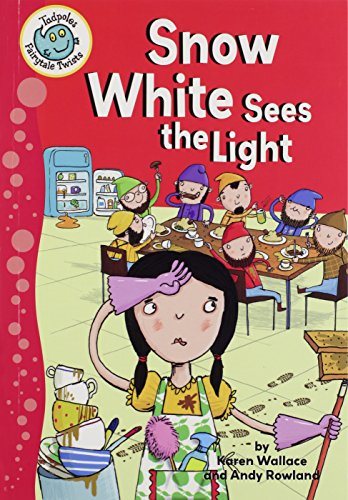| ________________
CM . . .
. Volume XXII Number 5. . . .October 2, 2015
excerpt:
Snow White Sees The Light is a twisted fairy tale which reworks the old story into a feminist tale, or at least attempts to do so despite an unconvincing final illustration. When the book begins, Snow White has become an unappreciated housekeeper for the lazy and demanding dwarfs. As their rude demands grow, Snow White begins to question if the dwarfs care for her or only for the service she provides. The dwarfs assure her verbally that they need her and love her, but their actions don't change, and, though Snow White continues in her role, resentment builds within her. The evil queen from the original story becomes the wise queen in this story. She has built a kingdom that successfully functions under the principle of shared domestic work, something which, the book declares, makes everyone happy. The queen uses her magic mirror not as a tool for her own vanity, but rather as a way to determine which of her subjects could most use her help. When the mirror directs her to Snow White, she suggests that the overworked girl could feign death by poisoned apple in order to see whether the dwarfs care for her or only for her housekeeping skills. The dwarfs are horrified and initially tearful when they believe that Snow White is dead, but they quickly reveal their main concern to be for their own well-being rather than any true grief at their supposed loss. Realizing she is as undervalued as she fears, Snow White leaves without a second thought. The book ends with the happily ever after message that Snow White found a "nice, considerate prince." The story is a cute and clever third-person retelling of a familiar story that has become outdated, though it remains beloved. It exchanges themes of female competition for supportiveness as the queen helps Snow White to find companions who value her. Though in the original story, all domestic chores are left to the women, in the new version, both men and women within a happy society are portrayed as equally capable of and equally responsible for domestic chores. Unfortunately, the strong message about equality within the text of this story gets undermined by one of Rowland's illustrations. Most of the illustrations are quite effective at providing readers with clues regarding the meaning of the words on the page, and they bolster the text in visual form. For example, the image accompanying the text where readers are introduced to the queen's happy kingdom of shared domesticity is colourful, and the playful nature of the apparently hand-drawn style suits the twisted fairytale genre. In that image, Rowland extends the text by depicting girls and boys sharing their tasks very happily both within the castle and on the grounds. By contrast, the final story image veers away from the message of the text. Instead of Snow White being shown as an equal partner to her considerate prince, Snow White literally lounges with bonbons on a couch while her prince performs the chores. Though the prince and Snow White are exchanging smirks, which may be read as a mutual awareness of the irony of their swap of traditional gender roles, the image feels wrong for the story. Up to this point, the depictions of the scenes have been straightforward representations of the text, and a straightforward reading of this image puts Snow White in the role of the lazy dwarfs, letting another person do all of the work rather than using the queen's recommended shared chore philosophy. A much more effective image would have had the two working together, perhaps with the prince cleaning the dishes and her drying them. However, putting the final image aside, Rowland's illustrations are otherwise appropriate and pleasing as they support the readers' understanding. Snow White Sees The Light is meant to be read by early fluent readers, as specified on the "Notes for adults" page. The back of the book contains resources for parents and teachers to use to enhance the engagement of young readers with the story. Resources include prompts that can aid children in connecting the story to the world and to themselves. At the end of the book, puzzles use visual representations of the scenes to provide readers with the opportunity to link characters and their speech bubbles; this tool can help adult readers gauge the textual understanding of their younger co-readers. The designation for "fluent" early readers is important because some of the words used may be quite challenging, including "dwarfs," "poisoned," and "considerate." A more experienced reading partner would certainly be beneficial for young readers attempting to read this story. Ultimately, I recommend this book to libraries and parents interested in encouraging early readers to challenge themselves. Twisted fairy tales generally provide a fun and engaging reading experience, and, despite the illustrated misstep on the last page of the text, this tale is no different. Snow White Sees The Light succeeds at providing a positive reading experience for young readers. Recommended. Devon Galitsky has a literature degree from the University of the Fraser Valley and lives in Chilliwack, BC.
To comment
on this title or this review, send mail to cm@umanitoba.ca.
Copyright © the Manitoba Library Association. Reproduction for personal
use is permitted only if this copyright notice is maintained. Any
other reproduction is prohibited without permission.
Next Review |
Table of Contents for This Issue
- October 2, 2015. |
